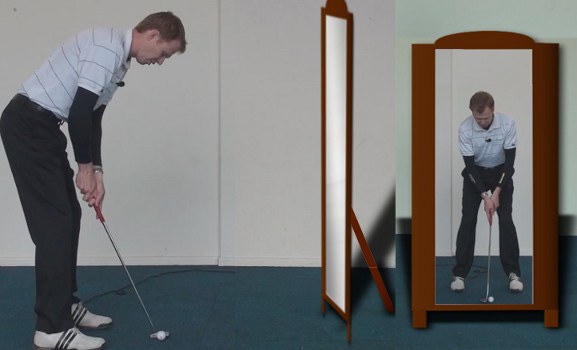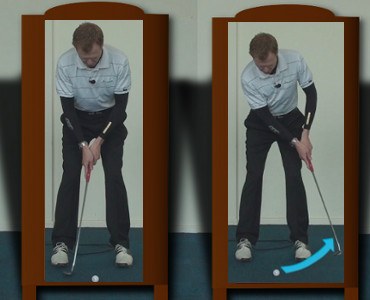
When you set up to putt, the ball is in the center of your stance with your eyes directly over it, right? Are you sure?
The question isn’t intended to cause uncertainty and undermine your confidence. The point is, it’s difficult to be positive about your positions based on what you see as you stand over the ball. And that’s where a full-length mirror, glass door or similar surface can help you establish and reinforce correct putting fundamentals.
Golf-Info-Guide.com explores how you can use a mirror to check your swing positions in two articles: Part I and Part II. Here we show you how to do the same with your putter.
First, check the following positions while directly facing the mirror, keeping in mind that putting fundamentals are a bit more flexible than those for the full golf swing:

- Ball position: Should be in the middle of your stance or slightly forward (toward the left foot for a right-handed golfer).
- Shaft angle: The shaft may be perpendicular to the ground or leaning a little toward the target.
- Weight distribution: Most good putters position their weight equally on both feet, but some, like Ben Crenshaw, favor the left side.
- Length of back-stroke and through-stroke: It’s often recommended that your back-stroke be shorter than your follow-through, which promotes acceleration. In any case, the back-stroke should not be shorter than the follow-through.
Now with the mirror to your side (right or left work equally well), examine these factors:
- Eye position: One thing nearly everyone agrees on is that the eyes should be directly over or slightly inside the ball.
- Arms and shaft: They should form a straight line from the elbows to the ground.
Feet and shoulder alignment: Square to the target line is ideal, though many good putters stand with their feet and/or shoulders open.
Using a mirror as a putting training aid can indeed help guide you to better putting. Here's how reflection can assist in improving your putting technique:
- Alignment and Setup: Placing a mirror on the ground behind the ball allows you to see your body alignment and setup from a different perspective. By looking into the mirror, you can check if your eyes, shoulders, hips, and feet are aligned parallel to your target line. This helps ensure proper alignment, which is crucial for accurate putting.
- Eye Position: The mirror can also help you check your eye position over the ball. Ideally, your eyes should be directly over the ball or slightly inside the target line. Using a mirror helps you visually confirm if your eyes are positioned correctly, promoting better sightlines and consistent ball contact.
- Stroke Path and Face Alignment: As you make your putting stroke, the mirror provides real-time feedback on the path and alignment of your putter face. You can observe if the putter is swinging straight back and through, without any unwanted deviations or twists. It helps in maintaining a square putter face at impact, leading to more accurate putts.
- Posture and Body Movements: A mirror allows you to monitor your posture and body movements during the putting stroke. You can observe if your posture is balanced and if there are any unnecessary body sways or shifts. Maintaining a steady and stable posture promotes consistency and control in your stroke.
- Visualization and Focus: By looking at yourself in the mirror, you can visualize the desired putting stroke and focus on specific areas of improvement. It helps in developing mental awareness and concentration, which are vital for consistent putting performance.
- Feedback and Corrections: The mirror provides immediate visual feedback on your putting technique. If you notice any inconsistencies or flaws in your setup, alignment, stroke, or posture, you can make the necessary corrections on the spot. This instant feedback loop allows for quicker adjustments and improvement.
- Training Aid Versatility: A mirror can be used both indoors and outdoors, making it a versatile training aid. You can practice your putting stroke at home, on the putting green, or even in a practice facility. It's a portable tool that can be easily incorporated into your practice routine.
Update:
Q&A Reflection is a valuable practice that can lead to improved putting performance on the golf course. By analyzing your putting performance and seeking answers to key questions, you can identify areas of improvement and develop a more effective putting strategy. Here's how Q&A Reflection can guide you to better putting:
1. Analyze Your Putting Stats: Review your putting statistics from previous rounds. Look at metrics like putts per round, putts per green in regulation, and three-putt avoidance. Identify patterns and trends that indicate areas needing improvement.
2. Ask Yourself the Right Questions: During your reflection, ask yourself targeted questions such as:
- Did I miss more putts on one side of the hole than the other?
- Were my three-putts due to poor distance control or misreading the greens?
- Did I consistently hit the ball with the intended pace on longer putts?
3. Focus on Alignment and Aim: Reflect on your alignment and aim during your rounds. Did you consistently line up your putts correctly? Did you accurately judge the break and slope of the greens?
4. Assess Your Green Reading: Consider your green reading skills. Did you read the greens accurately and adjust your putts accordingly? Were you paying attention to grain and slope when assessing your putts?
5. Evaluate Distance Control: Reflect on your distance control. Were you leaving putts short or consistently running them past the hole? Did you have a good feel for the speed of the greens?
6. Identify Mental Blocks: Ask yourself if mental blocks or negative thoughts affected your putting. Did you feel confident standing over the ball? Did you struggle with nerves or pressure on critical putts?
7. Set Clear Goals for Improvement: Based on your reflection, set clear and realistic goals for improvement. Focus on specific aspects of your putting that need work, such as alignment, green reading, or distance control.
8. Develop a Practice Plan: Design a practice plan that targets the areas you identified as needing improvement. Spend dedicated practice time on your weaker aspects of putting.
9. Seek Feedback from Others: Consider seeking feedback from a golf coach or a playing partner. A fresh set of eyes may identify issues in your putting stroke or alignment that you might not have noticed.
10. Stay Patient and Positive: Remember that putting improvement takes time and consistent effort. Stay patient and maintain a positive mindset throughout your journey to better putting.
Q&A:
Q: How often should I conduct Q&A Reflection on my putting performance? A: You can do Q&A Reflection after each round or every few rounds. Regularly reflecting on your putting performance helps track progress and identify trends.
Q: Can Q&A Reflection help me identify technical flaws in my putting stroke? A: Yes, by asking the right questions, you may identify technical flaws in your stroke, alignment, or setup that need correction.
Q: How can I work on my mental game through Q&A Reflection? A: Reflect on your mental approach to putting and identify any negative thought patterns or emotions that may be affecting your performance. Use the insights to develop mental strategies for improvement.
Q: Should I keep a putting journal to track my Q&A Reflections? A: Keeping a putting journal can be helpful to track your reflections, set goals, and monitor progress over time.
By regularly engaging in Q&A Reflection, you can gain valuable insights into your putting performance and take targeted actions to become a more confident and proficient putter on the greens.
Remember to combine mirror work with other putting drills, such as distance control exercises, gate drills, or reading green contours. The mirror serves as a visual aid to reinforce proper technique and help you develop muscle memory. With consistent practice using a mirror, you can refine your putting skills and become more confident on the greens.





